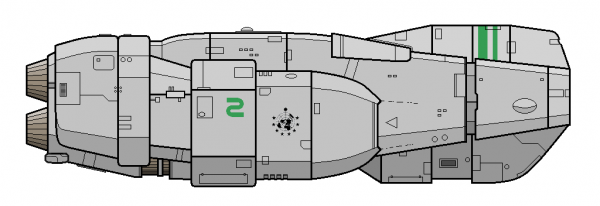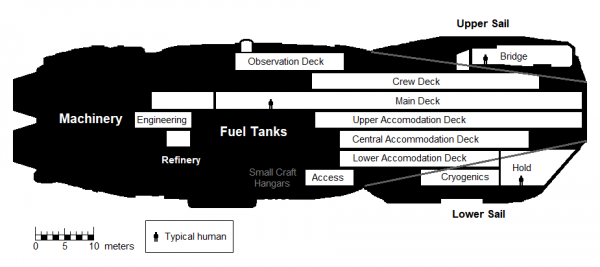Difference between revisions of "Besouro Valente class Personnel Transport"
| Line 44: | Line 44: | ||
== Description ([[Specifications]]) == | == Description ([[Specifications]]) == | ||
| − | The ''Besouro Valente'' class Transport is a historical design produced in the [[Terran Confederation]] during the first half of the 22nd century. | + | The ''Besouro Valente'' class Transport is a historical design produced in the [[Terran Confederation]] during the first half of the 22nd century. Ships of this class fled the [[Destruction of Terra]] at the hands of the [[Vilani Imperium]] in 2147AD, forming a part of the [[Last Armada]] and carrying with them the last remnants of [[Terra]]n culture and independence. The class were extremely sturdy and reliable and endured more than a century of spaceflight. They ultimately found and settled the [[Demon Cluster]], the region that later became known as the [[Distant Fringe]]. |
* It is a [[TL-11]] design. | * It is a [[TL-11]] design. | ||
* The class as described represents a vessel fitted out by the [[Expedition]] for service with the [[Last Armada]]: vessels in general [[Terran Confederation|Confederation]] service were not equipped with [[Artificial Gestation Unit|GenPod]]s. | * The class as described represents a vessel fitted out by the [[Expedition]] for service with the [[Last Armada]]: vessels in general [[Terran Confederation|Confederation]] service were not equipped with [[Artificial Gestation Unit|GenPod]]s. | ||
Revision as of 22:21, 18 November 2019
| Besouro Valente class Personnel Transport | |
|---|---|
 Terran Confederation vessel. | |
| Type: MP Personnel Transport | |
| Category | BCS |
| Size | 12,000 Tons |
| Hull Configuration | Cone Hull |
| Streamlining | Streamlined Hull |
| Tech Level | TL–11 |
| Engineering | |
| Computer | Model/4. |
| Jump | J-2 |
| Maneuver | 1 G |
| Armaments | |
| Hardpoints | 120 |
| Accommodations | |
| Staterooms | 0 |
| Personnel | |
| Crew | 129 |
| Officers | 14 |
| Enlisted | 115 |
| High/Mid Passengers | 0 |
| Payload | |
| Cargo | 239 Tons |
| Fuel tank | 0 Tons |
| Construction | |
| Origin | Terran Confederation |
| Year Operational | Circa 2100AD |
| End of Service | Circa 2500AD |
| Price | |
| Cost | MCr6,411.932 (base) MCr5,129.546 (qty) |
| Architect fee | MCrAde Stewart |
| Statistics | |
| Quick Ship Profile | MP-0AS12 |
| Images | |
| Blueprint | Yes. |
| Illustration | Yes |
| Source | |
| Also see | Last Armada |
| Canon | Published, fan design |
| Era | Interstellar Wars |
| Reference | Distant Fringe |
| Starships are designed with the Classic Traveller format, using Book 5 High Guard, Game Designers' Workshop 1980. | |
The Besouro Valente class Personnel Transport is an Auxiliary.
- It is a paramilitary ship and a Transport.
- The vessel is a TL-11 design.
- It is a historical class of vessel.
Description (Specifications)
The Besouro Valente class Transport is a historical design produced in the Terran Confederation during the first half of the 22nd century. Ships of this class fled the Destruction of Terra at the hands of the Vilani Imperium in 2147AD, forming a part of the Last Armada and carrying with them the last remnants of Terran culture and independence. The class were extremely sturdy and reliable and endured more than a century of spaceflight. They ultimately found and settled the Demon Cluster, the region that later became known as the Distant Fringe.
- It is a TL-11 design.
- The class as described represents a vessel fitted out by the Expedition for service with the Last Armada: vessels in general Confederation service were not equipped with GenPods.
Image Repository

A Besouro Valente class Personnel Transport of the Interstellar Wars period.
General Description
The Besouro Valente class is a streamlined flattened cone with a mean height of 28 meters, a mean width of around 45 meters and a length of approximately 95 meters. The hull is relatively irregular and some sections are narrower or wider, giving it a total enclosed volume of approximately 162,000 cubic meters.
Fuel tanks wrap around the central and rear sections of the ship. The cargo hold is located forward and is adjacent to the low berth section. Working sections of the vessel such as the sickbay, the galley, the laundry, and general crew quarters are located on the crew deck: senior officers are accommodated forward, close to the bridge, while stewards have rooms close to passenger areas. Accommodations are located on lower decks. The main commercial strip and leisure facilities are located on the broad forward half of the main deck. The aft section of the main deck is narrow and connects to the engineering control room.

A basic deck plan of the vessel indicating the general layout and positioning of major elements.
Basic Ship Characteristics
Following the Imperial Navy and IISS Universal Ship Profile and data, additional information is presented in the format shown here. The small craft factor indicates the number of squadrons (of ten craft) carried on the ship. Tonnage on the universal ship profile is shown in kilotons (thousands of tons) where necessary. [1]
| No. | Category | Remarks |
|---|---|---|
| 1. | Tonnage | The Personnel Transport is constructed using a 12,000 Ton hull built in a generally Conical configuration. The hull is fully streamlined, giving fair atmospheric performance that is further enhanced by its onboard gravitic systems.
|
| 2. | Crew | Total Crew Complement: 129.
Accommodations
There are 300 long-term Low Berths. They are tended by the vessel's medical staff.
It carries 2,000 GenPods and large embryo banks. Accessible areas of the hull are fitted with grav plates and inertial compensators and have full life support and environmental systems.
|
| 3. | Performance | The vessel mounts a DeVoss-type Jump-2 drive, a Maneuver-1 drive, and a Power Plant-2, giving performance of Jump-2 and 1-G acceleration. The ship has an agility rating of 1. The internal fuel tankage is sufficient for two consecutive Jump-2s and gives the power plant 4 weeks duration.
|
| 4. | Electronics | Adjacent to the bridge is a Model/4 computer: the vessel has a backup Model/4 computer sited near engineering.
|
| 5. | Hardpoints | 120 hardpoints.
|
| 6. | Armament | The normal weapons fit-out for a Personnel Transport is:
x60 triple Beam Laser turrets, typically grouped into six batteries of 10 linked turrets. |
| 7. | Defenses | The hull is unarmored.
x60 triple sandcaster turrets, typically grouped into six batteries of 10 linked turrets. The vessel is not fitted with screens or other passive defensive systems. |
| 8. | Craft | Flight Section
The Shuttles are housed in a dorsal hangar that has a total volume of 234 Tons. The Launches have two (port and starboard) dedicated hangars located ventrally, each with a volume of 156 Tons and accessed by a central assembly area: individual sections of each hangar can be sealed off. All hangars are accessed by large external doors. |
| 9. | Fuel Treatment | The vessel has internal fuel tankage of 5,040 Tons.
|
| 10. | Cost | The basic cost of the vessel is MCr6411.932
|
| 11. | Construction Time | 163 weeks (38 months) as standard.
|
| 12. | Comments | Standard cargo capacity amounts to 239 Tons.
|
History / Background
Besouro Valente class Transports were designed as troopships and constructed in large numbers at Terran-controlled shipyards throughout the early Interstellar Wars period. It was an Auxiliary vessel and was one of the more common examples of large ship acquired by the Expedition.
- The class is historical, dating from three and a half millennia ago – no extant examples are known to exist.
In addition to carrying passengers, some examples of the class also served as recreational venues (in some sources being referred to as "shore leave ships"). Such vessels were almost entirely given over to entertainment and leisure facilities, providing a vital break from the routine of Armada duties. A number of examples were converted to scientific research vessels, with dedicated laboratory facilities, and into specialist hospital ships.
Class Naming Practice/s & Peculiarities
Vessel Peculiarities:The class was always considered chronically underpowered, with serious performance issues in high-G environments. The vessel carried jamming equipment and an ECM package, intended to increase its chances of survival in potentially hostile situations. This was at best a lackluster counter to its very poor maneuver performance, which frequently left it as a slow, lumbering target that was easy prey for enemy combatants.
- Vessels that entered civilian service generally had their suite of jamming equipment removed.
Class Naming Practice/s: The name means "Courageous Beetle" in the old Terran language of Portuguese. Its crews often called it something far less heroic: the "Beijo da Morte" class was one of the more common. [3] Individual vessels were generally named by the building yard, often carrying the names of members of the construction team's families.
Variant Models
Later variants of the class had an upgraded (and substantially larger) maneuver drive, installed at the expense of some personnel accommodations.
Selected Variant Types & Classes
Civilian Ship - Merchant Ship - Passenger Freighter:
- Type MP class Passenger Freighter
- Gaia class Luxury Liner
- Horizon class Passenger Freighter
- Jelmirt Marquis class High Liner
- King Richard class Interstellar Liner
- Last Armada class Personnel Transport
- Nebula class Starliner
- Olympian class Cruise Liner
- Royal class Interstellar Liner
- Sapphire Moon class Moduleship
- Shuvalivashtu class Luxury Liner
- Clii Argu class Common Transport (Type TC class Common Transport)
References & Contributors (Sources)
| This article has metadata. |
| This article is missing content for one or more detailed sections. Additional details are required to complete the article. You can help the Traveller Wiki by expanding it. |
- Marc Miller, Frank Chadwick, John Harshman. High Guard (Game Designers Workshop, 1980), 20-37. (Design Sequence Used)
- Traveller Wiki Editorial Team
- Author & Contributor: Lord (Marquis) and Master Scout Emeritus Adie Alegoric Stewart of the IISS
- Contributor: Bruno Vieira Barbosa Carneiro
- Author & Contributor: Lord (Marquis) and Master of Sophontology Maksim-Smelchak of the Ministry of Science
- ↑ Timothy B. Brown. Fighting Ships (Game Designers Workshop, 1981), 10.
- ↑ Timothy B. Brown. Fighting Ships (Game Designers Workshop, 1981), 10.
- ↑ Information provided to the library by Bruno Carneiro